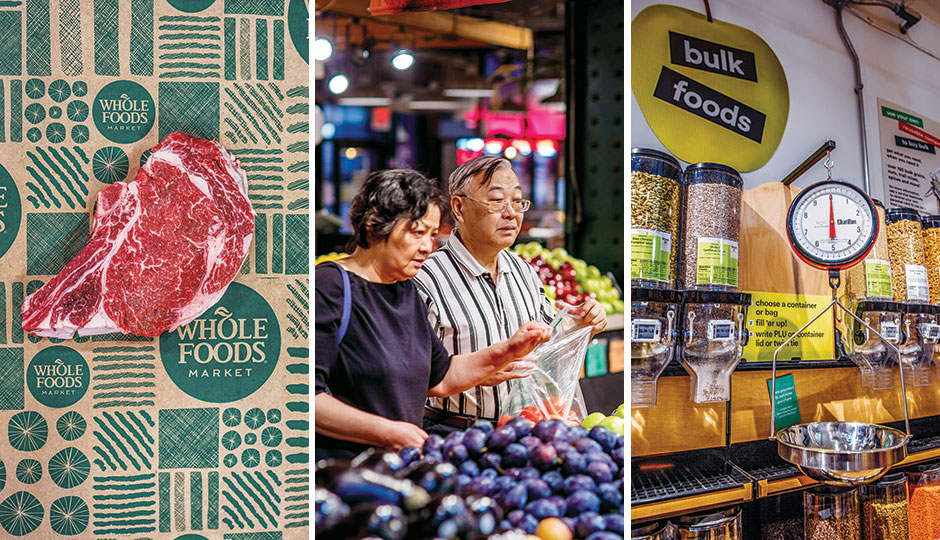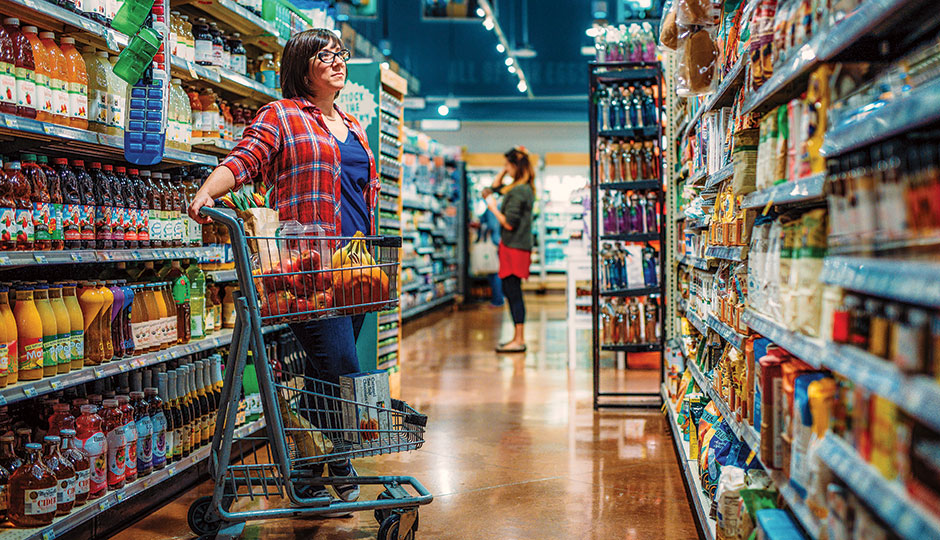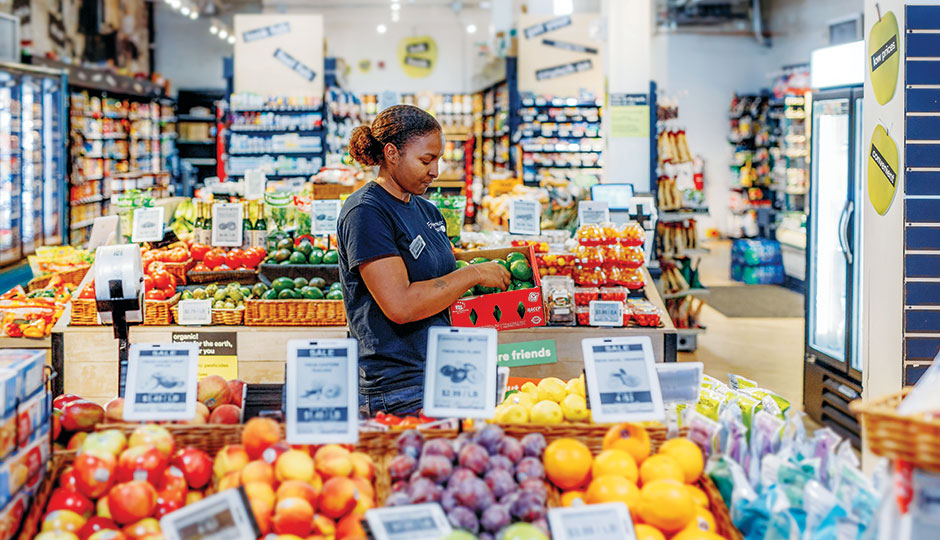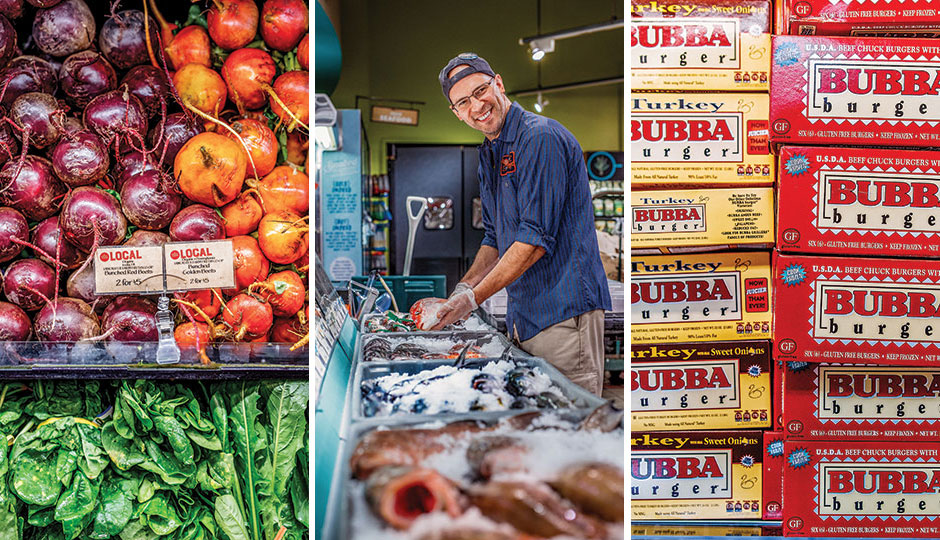What the Philly Grocery Store Boom Is Really About

Photography by Jeff Fusco
In early 2008, not long after I came out of a not-excellent relationship, landed a new job and moved to Philadelphia, I found my soul mate at the supermarket. Okay, my soul mate was the supermarket — specifically, the Trader Joe’s around the corner from my apartment.
Like most affairs, this one didn’t really start with love. I just felt lucky that I had such a decent place to shop so close by, even if the cramped store always felt like blizzard shopping, all bumper-carts and panicked grabs for the last box of Puffins. (I once watched a man in the middle of a line so long it wrapped around the store heave a sigh, abandon his basket on the floor — milk and all! — and stomp out the door. As one friend says: “The lines and the parking lot there are like you’re on Candid Camera.”)
But as time went on, I found that it wasn’t just about the convenience of geography: I adored the happy-go-lucky vibe and the friendly (stoned?) dudes in Hawaiian shirts, the punnily named products (“Hold the Cone” mini-ice creams! Adorable!), the famously well-edited selection of frozen meals, the planet’s most addictive chocolate-pistachio toffees. So what if Trader Joe’s didn’t carry fresh shrimp or Ben & Jerry’s or contact solution? The whole store felt like me, or the person I fancied myself to be. Organically inclined, but not overly crunchy. A little more special than Acme, but not as upmarket as Di Bruno’s. Good-humored, not terribly experimental, disinclined to excess and preciousness, with a tendency to overdo it on the snacks and the avocados.
When I moved across town to Fairmount a few years later, I bravely tried to transfer my loyalties to the Whole Foods, which was much closer to my new place and boasted a cult of followers (many of them my friends) so staunch, they made the Scientologists look like Brownies. Somehow, though, it just never took. Sure, the place was gorgeous, the bakery’s cakes were light as air, and the olive selection was basically the eighth wonder of the world. And I was happy enough to pop in for the pre-formed grass-fed burger patties (the best in the city). But I never really felt like I fully belonged amongst its gluten-aware, multi-tattooed denizens. I mean. These people actually remembered to bring their own bags.
“Whole Foods is bullshit,” offers a colleague of mine. “All that effort going into feeling authentic and romanticizing food shopping when the place is all about Ayn Rand-style capitalism.” He prefers Aldi, where “you’re shopping in a gray box with no music; they barely even have shelves. What they have is great stuff, cheap, for which you trade money. That, my friend, is a pure experience.”

Photography by Jeff Fusco
Of course he loves Aldi, another colleague weighs in: “That’s so him.” I know what she means: a tad iconoclastic, pragmatic, proudly unpretentious. She herself shops at the Weavers Way Co-op in Mount Airy — which is, I must say, so her (sensitive, thoughtful, principled).
Attention, shoppers! Whether or not you agree with the opinions expressed here is beside the point. The point is that these kinds of conversations about supermarkets and identity have become increasingly commonplace in Philly lately, as a direct result of Center City’s changing supermarket scene. Surely you’ve noticed. The local Superfresh? Gone. In its place, a gussied-up Acme or Fresh Grocer. Bottom Dollar bottomed out, and in came Aldi. Two new city Targets are dedicating some 30 percent of their floor space to groceries, and Oregon Avenue’s Pathmark has been replaced by a magnificent new ShopRite with an in-store dietician, delivery service, and a meat counter to die for. Plus: The Market Street Trader Joe’s expanded in 2013 (it’s hardly palatial, but there’s significantly less panic per square foot now); a Maryland-based chain with a cult following, Mom’s Organic, is slated for Midtown Village; the German-based grocer Lidl (pronounced “LEE-dul”) is reportedly eyeing Philly for its U.S. expansion; and a chain called Everything Fresh plopped a 3,000-square-foot market in a grocery-barren stretch of the Gayborhood. They’ve also got at least one more planned, in Queen Village.

Photography by Jeff Fusco
This multitude of riches can’t be found everywhere in the city; there are still neighborhoods that lack any grocery stores. In the suburbs, of course, shoppers have always had a host of supermarkets to choose from — not to mention that mecca of markets, Wegmans. But the spate of new grocers in Greater Center City is remarkable. We have choices now — choices that run deeper than mere convenience or more types of peanut butter to choose from. They offer more ways to connect to something, to define yourself and find your place in the world. Even if that place happens to be the cheese aisle.
WHEN I WAS GROWING UP, my family was a Kroger family, in the purest sense: My father was an executive for the supermarket chain (which is based mostly in the Southeast and Midwest), and if that connection wasn’t enough to guarantee my brand loyalty, the cow heart he rustled up from the corporate butcher for me to take to third-grade science class certainly was. (I went from being the girl who sat behind pretty Mollie Ward to the girl whose dad could secure animal parts from Kroger. Trust me, this was a step up.)
So enmeshed was that store in my formative years that I never imagined a day when I might stray from Kroger — but then, I never imagined moving to Philly, or, for that matter, that there would be so many other options with so much cool stuff happening inside. But to be fair, who in 1980s suburbia could have predicted something like the new Whole Foods Market at 20th and Hamilton, which sounds more like a glorious cruise ship than a supermarket?
It’s only been open a few weeks, this 62,000-square-foot behemoth — the new flagship for the mid-Atlantic region — but it’s had Whole Foodies in a lather for months over its spaciousness and the extreme luxury of its attached parking garage. (Its neighbors should be the happiest of all: According to Zillow, homes within a mile of a Whole Foods have a median value more than double that of those that aren’t so close, which says a lot about what some people will do for easy access to Annie’s Organic Cheddar Bunnies and Uncle Matt’s Matcha Lemonade.)
This new store is nearly twice the size of the Whole Foods it replaced on Callowhill, bigger than the other, 32,000-square-foot outpost on South Street. Here, shoppers can relax with a glass of wine or a local beer from the in-store pub, enjoy a handcrafted Neapolitan pizza in the 140-seat dining hall, pop by an elaborate European-style coffee bar, or grab takeout from one of four in-store restaurants, including a Cheu Noodle Bar, a Dizengoff, and a Wiz Kid, which is the new vegan spin-off from Vedge’s Rich Landau. You can also buy groceries, if you want.
Should you appreciate (or not) this and similar bursts of luxury that have been popping up in the supermarket scene of late — and I don’t just mean chardonnay-sipping at Whole Foods, but also the organic “O” line at Acme, a well-curated bottle shop at IGA, the mobile shopping app at Fresh Grocer, delivery options almost everywhere, and the mere existence of niche markets that specialize in, say, organic foods or extremely low prices — you can thank (or blame) a millennial. The 35-and-under set may not be old enough to run for president or rent a car, but the power they wield over corporate America seems to more than make up for that.
The traditional supermarket model — Kroger, yes, but also your Acmes, your ShopRites, your Giants, your Save-A-Lots — has actually been in the doldrums for a couple decades now, as price clubs and high-end specialty stores and chain drugstores proliferated in the ’90s, bringing intense competition to all ends of the spectrum. And a younger generation of shoppers has only added to the issue, says Ben Davison. Davison, who grew up on the outskirts of Philly, is now a doctoral student at the University of Virginia and is writing a book about the history of the American supermarket.
“Millennials have eschewed a lot of the older, more established supermarkets — the places their parents shopped at,” Davison says. “Young people don’t trust traditional mass retail chains because they’re not as environmentally or socially palatable to them.” Shopping, he adds, isn’t just about nutrition, or geography, or even affordability: “Often, buying food is a manifestation of our own identity.”
Clearly. (Trader Joe’s, ç’est moi!)
But why, any reasonable person might wonder, do the identity politics of young consumers matter so much — especially these young consumers, a generation known for their general antipathy toward buying stuff? Davison’s answer: “Urban millennials are seen as the future of economic significance.” And also: “Brand loyalty comes together before a person turns 30.”

So, not surprisingly, supermarkets of all stripes are vying for the base of still-unformed 29-year-olds in a bunch of different ways. Not only are more stores going into more cities, but there are also more varieties of stores (all-organic! All-discount! Organic discount!), to appeal to the many different identities and priorities and wallets out there.
Traditional supermarkets — which spent much of the last century gearing themselves toward a mostly white, often affluent suburban demographic that valued predictability and sameness — are basically doing a 180, looking to younger, more diverse, more urban shoppers who want authentic, personalized, experience-driven, convenience-oriented, affordable service, bless our spoiled little hearts.
Cities all over the country are seeing this type of supermarket revolution, but no one feels the transformation so keenly as we do here in Philadelphia — or, as Davison calls us, “the orphan of the Northeast.” After all, as one foodie friend points out, “In New York, everyone lives within four blocks of a supermarket, even if it’s just a little D’Agostino.” (Did you already guess she’s a former New Yorker?) “Here, it’s so bizarre to me that we live in this big, cosmopolitan place and you can still not be within a 10-block radius of a grocery store, even in a nice, expensive neighborhood.”
Typical New Yorkiness of this aside, there’s truth to the complaint that Philly is, as one retail broker recently put it to the Philadelphia Business Journal, “under-grocered” — not just in our notoriously underserved communities (the term “food desert” has fallen out of fashion), but in busy, bustling, developing Center City, too. It’s a shortcoming we can trace back to the 1950s, Davison says, when the city entered an economic and cultural rough patch that would last much of the second half of the 20th century. Neither the middle class that had traditionally attracted supermarkets nor the city was growing the way New York and D.C. were. Nor were we a leader in the fine-dining scene of the ’80s and early ’90s, Davison points out. So while newly dubbed “foodies” were luring supermarkets to cities on both coasts, Philly wasn’t in on the action.
“When I first moved here 32 years ago, I’d go up to the Thriftway on Girard to shop,” recalls one Fairmount neighbor who now lives within walking distance of the new Whole Foods. “The bread was stale. The canned goods were expired. It was the saddest, dreariest place. But we all went there. That was what there was. I had a car, so I sometimes would drive out to Roxborough, where there was a good Acme. But it certainly never felt … special.”
To think that her neighborhood supermarket is now home to a beer bar and a CIA-trained chef preparing the takeout burritos! The city’s back, baby — restaurant scene, real estate, strollers and all — and absolutely jammed with millennials. They now make up some 40 percent of Greater Center City’s population, and the food retailers are noticing, big-time. Why do you think there are 15 different kinds of apples (five of them organic) in the produce aisle?
It is, however, well worth noting that this largesse hasn’t reached all corners of the city; there are still some desolate grocery aisles around town, and we’re still chipping away at the issue of fresh-food access for everyone. Though that problem, too, has improved over the past 15 years, says Gabriella Mora, senior associate for policy and government affairs at the Food Trust, the nonprofit whose mission is to ensure all citizens access to fresh, healthy food. In recent years, she says, grocers have in some cases chosen new locations expressly to serve the underserved communities. (Notable examples: ShopRite and Fresh Grocer.) “We really celebrate the successes,” she says. “It’s been transformative. But there’s still work to be done.”
It’s hard not to be optimistic about the potential reach of the grocery revolution, given the push by the Food Trust and its partners, and also the sunny foodscape forecasts from experts like Burt Flickinger III. Flickinger, a retail consultant who’s been analyzing the Philly market for 35 years, says Philly isn’t just hot when it comes to grocery stores right now; it happens to be “one of the highest-opportunity markets in America.”
THE PLETHORA of changes in the modern foodscape may have made shopping easier and even more fun, but for shoppers who have a choice, choosing where to shop has gotten a bit more complicated. There’s so much more to consider, as Davison notes, beyond just price and geography: How do you feel about GMOs? About knowing your farmers? Fair trade? Luxury brands? Tastykakes? Live lobsters? Nut butters? Hipsters? Cheap-chicken Monday? Guilt?
Except for asking about their children or their Netflix queue, nothing gets people to open up faster than inquiring about where they shop and why:
Aldi! I don’t make menus or complicated lists: I shop for what’s a good price and then build my cooking off of that. I like to go in with an open mind. The “Aldi Finds” aisle always has the best impulse buys — one week I bought a gel mat for my dog that was $9.99; another time, it was a digital kitchen scale for $8.99.
I try to do veggies from a CSA, meat from Whole Foods, and packaged foods from Walmart or Acme. I say I “try” because sometimes it’s just too expensive to do the “right thing.”
ShopRite used to be the cheapest place you could shop at. I remember being embarrassed my mom shopped there. But I swear, the new ones are rivaling Wegmans with their prepared foods and their quality and their healthy-eating sections.
Reading Terminal Market is the best. I love Trader Joe’s for certain items but need an Ativan to deal with the packed aisles. Whole Foods is off my list now that I know what a budget is.
I just love Whole Foods so much. The lighting is more natural than anywhere else, and I feel like they’re ahead of the curve in food trends. They make the experience so pleasant. Sometimes I don’t need anything, but I’ll just make up an excuse to go.
As is true of so much in modern life, grocery shopping isn’t just grocery shopping anymore; it’s an event. Consider my neighbor Scott, who treks from Fairmount to Reading Terminal Market to do his grocery shopping most weeks — not just because the meats and produce are very good, he says, or because the prices are “surprisingly competitive,” but because he likes the vibe: “Reading Terminal is crowded and loud, and it’s not always easy to shop there, but it’s got character, and we get the whole experience along with whatever we need. I’ve been taking my son since he was six weeks old; the purveyors know me, they know him. There’s a little community there.”

Photography by Jeff Fusco
You would not believe the number of people I talked to who said they wished they could shop at Reading Terminal more than they do. (Evidently, convenience wins out over the pursuit of experience in many cases.) Nowhere in this city provides as romantic an ideal of shopping as Reading Terminal, where you stroll under warm, twinkling lights, forage from the mom-and-pop cheese shop, chat with the whoopie-pie guy, see the fish glisten in their icy bed.
But our widespread longing has to do, too, with that sense of community Scott loves — which is exactly what our shared, albeit limited, neighborhood grocery once provided, that chaotic melting pot for all walks of life. We met our neighbors, teachers, gas-station attendants there; we saw what brand of toilet paper they bought, whether their carts contained tonic water or Tylenol or Tums. There was intimacy; we were reminded of all we have in common. And no amount of excellent cheese and live lobsters at the new ShopRite can relieve a vague urbanist unease that in silo-ing ourselves according to our food interests and preferences, we’re becoming isolated from neighbors whose budgets or lifestyles don’t align with ours. Not to mention forgoing visits to the real, actual Latino markets in South Philly for the less authentic comforts of, say, Trader José’s.
The truth is, no matter how many tribes we split ourselves into, my neighbors and I are, first and foremost, city people. That’s why we live here: We were drawn to Philly by its size and diversity. Our new food loyalties may be many, but nothing supplants a city-dweller’s instinct for foraging, or a Philadelphian’s unyielding devotion to a cultural touchstone. Which is why so many of us — supermarkets aside — still go out of our way when we can to hit Reading Terminal and Di Bruno’s and Sue’s Produce and corner bodegas. We hope that maybe, here in the city, we can have our Chinatown bakeries and our Whole Foods cake, too.
Which brings me to Klein’s Supermarket. Klein’s is a homey, well-stocked, smallish grocery in my neighborhood that’s been a staple since 1979, and in business in Philly since 1892. Ken Klein, who runs the store with his two brothers and a nephew, is a fourth-generation owner, and he says there are way more “pieces of the pie” in Fairmount now: “We have to be careful, sharpen our pencil, watch our bottom line, keep hiring the right personnel.” The store, he says, is only as good as the people you have.
The people at Klein’s, for the record, are lovely. Employees once cooed so lovingly over my newborn (and carried my basket for me while cooing) that three years later, I still get warm fuzzies walking in the door. Klein’s has a dedicated customer base, a primo spot on the first floor of a condo building, a great little deli counter, good selection, fair prices, and whipped cottage cheese that one of my friends obsesses over. But Klein’s is also a handful of blocks away from the new mega-Whole Foods. Does that make Ken a little … nervous?
“Yes,” he says, bluntly. When the first, smaller Whole Foods opened, it had an impact. “But it didn’t put us out of business. This one won’t, either. I don’t know how it’s going to affect us yet, but it will affect us. Every change in the scene affects us.” Don’t even get him started on the rise of online grocery shopping and delivery.
Ah, delivery. If buying food at ShopRite says I value variety and great prices, and shopping at Di Bruno’s says I’m fancy and/or wealthy and/or throwing a dinner party, then having one’s groceries delivered via Peapod or Instacart or FreshDirect says something much less interesting that could nevertheless apply to a vast number of us: I’m really busy, and I’ll pay someone to relieve me of this chore. Given our culture’s emphasis on convenience and a service economy, it’s a wonder more of us haven’t joined this tribe. “Deliveries are the next frontier,” historian Davison says. Even 7-11 is experimenting with delivery by drone.
Not everybody, though, is ready to sign on.
“I really hate delivery,” says a friend who’s a chef and nutritionist. “I tried to go online to do my shopping, and I aborted the mission after five minutes. I got so anxious trying to decide what I wanted from the screen.” Sometimes, what’s meant as convenience brings on its own set of problems. Besides, there’s such a thing as pride, at least in her profession: “I can’t just have some random person picking out my produce.” Not when there are 15 different varieties of apples (five of them organic) for sale on any given day.
Published as “To Market, To Market” in the November 2016 issue of Philadelphia magazine.


